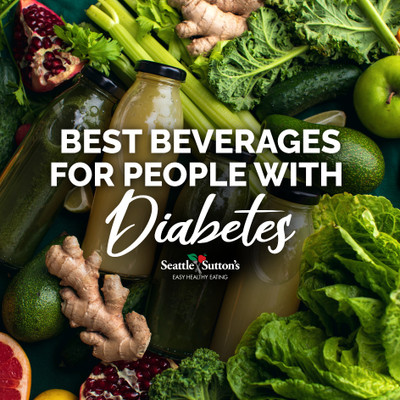Are "Net Carbs" Important for Weight Loss?
It is very likely if you’re reading this you have been hit by the low-carb and keto craze over the last few years. It seems like everywhere you turn there are remnants of this diet trend. This craze has caused confusion over how to read food labels, fear of nutrition powerhouses such as fruits and beans, and left followers susceptible to “low carb” marketing tricks.
The rates of obesity have continued to climb over the last few years, leaving many people desperate to lose weight and unsure where to turn. New research revealed that kids and teens’ BMI almost doubled during the pandemic compared with prior years, and the percentage of kids and teens with obesity also increased. Kids are not alone with their weight gain, many adults found the lack of structure, increased stress, irregular mealtimes, and increased screen time made it hard to maintain a healthy weight.
One report claimed that Gen Z adults (ages 18-24) who reported undesirable weight gain put on an average of 28 pounds during the pandemic and among millennials (ages 25-42) the average was 41 pounds. Other age groups also saw undesirable weight gain in this survey, among Gen X (ages 43-56) 41% reported undesirable weight gain, Baby Boomers (ages 57-75) reported 37%, and older adults (age 76+) reported 25% had gained weight without trying.
When people hear of other’s success with a diet or the buzz on social media they are eager to try what seems to be the answer to their weight loss needs and a quick solution to their problem. But we all know that fad diets come and go and without a focus on long-term change which is sustainable for the rest of your life, it may be a trap for long-term failure. Experts suggest that as many as 80-95% of dieters gain back the weight they’ve worked so hard to lose.
The low-carb and keto diets have people over-focusing on carbohydrates. A very low carbohydrate diet is an eating plan that is high in fat and protein and restricts the amount and types of carbohydrates someone eats. This can lead to an unbalanced diet which can be over the recommended amounts of sodium, cholesterol, and saturated fat for the day. It’s important to understand what is a carbohydrate, why they an important part of a healthy diet, and also how to properly read a food label.
What Are Carbohydrates?
Carbohydrate foods have a place in a healthy diet. They provide our bodies with energy, fiber, vitamins, and minerals. The American Heart Association and the American Diabetes Association recommend getting 45-65% of your daily calories from carbohydrates with a focus on natural, nutrient-dense carbohydrates. Some examples of healthy carbohydrates include fruits, vegetables, beans and legumes, low-fat dairy, and whole grains. At Seattle Sutton’s Healthy Eating, our meal plans average 47% of calories from carbohydrates and we emphasize fresh wholesome ingredients. Focusing on these good carbohydrates provides heart-healthy benefits, health-promoting fiber, and high amounts of vitamins and minerals.
Simple carbohydrates are digested quickly and send immediate bursts of glucose (energy) into the bloodstream. They are found in refined sugars, like table sugar, and processed carbohydrates. They provide energy but lack vitamins, minerals, and fiber and can lead to weight gain. Processed carbohydrates that contain high amounts of simple sugars, such as Oreos or Pepsi, can raise your triglyceride levels. Triglycerides are an important marker of metabolic health. If your triglycerides are high you may have an increased risk for coronary heart disease, diabetes, and fatty liver. However, complex carbohydrates, like fresh produce or whole grains, can help lower your cholesterol and reduce your risk for heart disease.
Why Do I Need Carbohydrates?
High-quality carbohydrates help you feel fuller longer, give you energy for a longer period, and provide important fiber, vitamins, and minerals. The fiber from healthy carbohydrates can promote good bowel health, reduce the risk of constipation, and can reduce cholesterol levels. Research shows that a diet high in fiber is associated with a lower risk of cardiovascular disease, type 2 diabetes, and bowel cancer. Including these foods has also been shown to help promote a healthy weight due to their ability to promote satiety and lower calorie count when compared to high-fat foods. If you were to replace fatty foods or sugary drinks with high fiber items, you will reduce the total number of calories in your diet and feel fuller.
What Are the Dangers of Cutting Carbohydrates Too Low?
Significantly reducing the carbohydrates in your diet over a long period could mean you do not get enough nutrients, potentially leading to health problems. Additionally, if you replace carbohydrates in your diet with fats and high-fat proteins you could significantly raise your intake of saturated fat, which can increase your risk for heart disease. If inadequate fiber intake you could struggle with constipation and an increase in unhealthy bacteria growth in your digestive tract because fiber (prebiotics) provide food for the good bacteria (probiotics) to maintain a good balance of for good health.
How to Properly Read a Nutrition Label?
Reading a nutrition label is an important skill to understand exactly what you are getting from your food. It is important to decrease the amount of saturated fats, trans fats, sodium, and added sugars that you are consuming. While increasing the amount of healthy fat, fiber, vitamins, and minerals your food provides. When someone is following a very low carbohydrate diet, they are often only looking at the carbohydrates and not paying much attention to the other nutrients that we should be limiting. We recently compared our meals to our competitors and were shocked to find that our competitor that aligns themselves more with the keto diet had 210% of the daily saturated fats and were more than 10% over the Dietary Guidelines recommendations for sodium per day.
The total carbohydrates per serving are listed on a nutritional facts panel. Indented under total carbohydrates you will find fiber, sugar, added sugars, and sugar alcohols, which are all included in the number of total carbohydrates.
FIBER: Fiber is often found in the cell walls of foods that come from mother nature. Good sources of fiber include fruits and vegetables, whole grains, and pulses (beans and lentils). The adequate intake for total fiber is 21-38 grams per day, however, the average fiber intake among Americans is 16 grams per day. It’s important to know that all fibers are not the same. Some are viscous and have the ability to thicken the contents of our intestines. This slows the entry of glucose into the bloodstream. While some ferment in the digestive tract, others are very resistant to fermentation. Some are soluble while others are insoluble. These are all factors which influence our health differently.
SUGAR: There are two different kinds of sugar , natural and added. Recently, the nutrition labels have started to separate out the total sugars and added sugars. Naturally occurring sugars are not bad in moderation and our bodies can use them as a main source of energy. There is no recommendation for natural sugars consumed per day. This would include sugars from fruits and dairy products which also contain healthy fiber, vitamins, minerals, and antioxidants. There is a recommendation for less than 50 grams of added sugar per day (our plans average between 14-21.5 grams per day).
The way our bodies metabolize naturally occurring sugar is different than how it metabolizes added sugars. Our bodies break down added sugar quickly, causing a quick spike in insulin and blood sugar. We often feel less full on these foods. The fiber and nutrients in foods with naturally occurring sugar are digested much slower, leading to feeling fuller with fewer calories and slowing down the rise in blood sugar.
SUGAR ALCOHOLS: Sugar alcohols are a type of sweet carbohydrate. They are like a hybrid of sugar molecules and alcohol molecules. However, they contain no ethanol so they are safe for someone who has an alcohol misuse disorder. Most sugar alcohols are not naturally present and are processed from other sugars, such as glucose in cornstarch, and then added to a food. They are partially resistant to digestion so act similarly as dietary fiber. They are not approved for the FODMAP diet , which means they may cause stomach pain and bloating in certain people. They do contain calories but are much lower than regular sugar. The majority of sugar alcohols have little to no effect on blood sugar and insulin levels, this fact and since they are sweet is a common reason why people choose to use them.
What are "Net Carbs?"
Have you heard the term “net carbs?” It is a popular word thrown around in the low-carb diet circles. Similar phrases such as impact or active carbs are another way companies describing net carbs. Did you know that there is actually no official definition of net carbs? They are often a marketing tactic that can be deceiving.
Food manufacturers invented this new type of carbohydrate which promises dieters that they don’t have to give up their sweets. Net carbs are not required to be listed on the label, only fiber and sugar. Any net carb claims you see on a label have not been evaluated by the FDA. The terms have been made up by food companies and are a marketing tactic to draw attention and give the appearance that the food item is “healthy.” The science behind these claims is fuzzy and it has not been revealed if counting net carbs help or hurt weight loss efforts.
The idea behind net carbs is that our body digests each type of carbohydrate differently. The “net carbs” are the carbohydrates that you digest and use for energy, the remaining carbohydrates are thought to pass through the digestive tract without being absorbed and without significantly impacting your blood sugar. Proponents of this diet rule suggest that low net carb foods do not have a significant impact on blood sugar and therefore are less likely to prevent weight loss. As I mentioned above, it is not exactly true that all fibers and sugar alcohols are created equal and impact the body the same way.
To calculate the amount of “net carbs” of an item, food companies take the total carbs and subtract the fiber and sugar alcohols. This is because fiber provides roughage to the body and passes through our digestive system intact. Sugar alcohols are an indigestible item so the body has a lessened response when they are eaten in place of actual sugar.
Net Carbs = Total Carbs – Fiber – Sugar Alcohols
Once you subtract the number of fiber grams and sugar alcohol grams, you will then have the amount of “net carbs” in an item.
What Do I Need to Know About Net Carbs?
There are a few important things to consider when looking at net carbs.
- Total carbohydrates still matter. Sugar alcohols can still impact blood sugar and if you have diabetes paying attention to the total carbohydrates you are consuming at one time is important for your overall blood sugar control. Just because you are eating a pie with sugar alcohols in it, you are still getting carbs from the flour, fruit, and so on. Your sugar-free pie is not carbohydrate-free. Portion control is also key for blood sugar control.
- Excessive fiber and sugar alcohols can lead to digestive distress. If you suddenly change from a low fiber diet to one with a lot of commercially-added fiber, you may experience gas, bloating, and changes in bowel movements.
Research has shown over and over that fiber is important for good health. Getting adequate fiber in the diet helps with blood sugar control, weight management, sustained fullness, and lowering cholesterol. But it is important to ease yourself into a higher fiber diet and to drink plenty of water.
Sugar alcohols, as mentioned above, are indigestible, which means they are not absorbed. The bacteria in your gut can ferment sugar alcohols. This can lead to gas, bloating, and diarrhea. If you start buying a lot of products touting their net carbs, it is likely they are using a large amount of sugar alcohols to keep their products sweet while subtracting more off the total carbohydrate. It is a good idea to limit yourself to less than 15 grams of sugar alcohols.
- Focus on healthier sources of carbohydrates. I have had many conversations with people over the past few years who were convinced that a piece of bacon was better for their health than an apple. Or who will pig out on sugar-free cake but won’t touch beans because they are too high in sugar and carbs. Research has shown many times that eating a variety of plant foods is vital for good health due to the natural fiber, variety of anthocyanins and polyphenols, high water content, and more. When people are afraid to eat natural foods because of their sugar and carbohydrate content, they are missing out on a variety of nutrients and nutritional properties that processed foods just can’t provide. Carbohydrates should make up at least 45% of the calories in your diet. Focus on a variety of fresh foods, less processed carbohydrates, and portion control instead of processed items with added fiber and sugar alcohols.
Are All Sugar Alcohols Created Equal?
In the world of “net carbs,” food companies have different rules for different types of sugar alcohols. Not all sugar alcohols are free of carbohydrates. Some companies play with these numbers to make it appear as though they have lower "net carbs" than they actually do.
These sugar alcohols can be subtracted by their entire amount toward the net carb:
- Erythritol
- Lacititol
- Mannitol
- Xylitol
However, the following sugar alcohols can only be subtracted by half their entire amount toward the net carb:
- Isomalt
- Glycerin
- Maltitol
- Sorbitol
For example, if you had an item that had 30 grams of carbohydrates, 2 g of fiber, and 6 grams of maltitol you would calculate the net carbs by subtracting 30-2= 28 grams and then subtracting half of the maltitol, 28-3= 25 grams of net carbs.
Are "Net Carbs" Important for Weight Loss?
For weight loss and overall health, it is recommended to focus on evidence-based weight management strategies, healthy eating, physical activity, and chronic disease prevention. This means focusing on a balanced diet to provide your body with all of the nutrients it needs, as well as committing to changes that you can maintain over many years.
There is no evidence that a low-carb diet is more effective in the long term in people with type 2 diabetes than other diets, such as a calorie-controlled diet. One research study found that a low-fat diet led to less overall consumption and led to more fat loss than those following a keto diet. They also reported that the keto group lost more fat-free mass (which is typically water weight or muscle mass). Water weight often is quickly regained once returning to a normal diet and loss of muscle mass is hard to regain and can led to a slower metabolism. A loss in muscle mass increases the chance of weight gain and can make it more difficult to lose weight in the future. A National Lipid Association review from 2019 concluded that a low-carb and very-low-carbohydrate diet are not superior to other dietary approaches for weight loss.
Lastly, ask yourself and be honest…am I never going to eat a diet with a normal amount of carbs? Do I plan to eat like this 2, 5, 10 years from now? Most diets fail because people can’t follow them and a very low carbohydrate diet is no exception. Individuals who lost a lot of weight on keto who have since returned to their typical eating pattern report a significant weight gain.
Foods touting their net carb content may still be very high in calories. For weight loss it is important to balance the calories you’re taking in with what you are burning off each day. It’s best to focus on an overall balanced diet, full of a variety of colors, and closest to mother nature as possible
Interested in eating healthy? Hungry for more?








 Weight Loss
Weight Loss Health & Wellness
Health & Wellness Diabetes
Diabetes Heart Health
Heart Health Motherhood & Family
Motherhood & Family Dietary Restriction
Dietary Restriction Other Health Conditions
Other Health Conditions About SSHE
About SSHE


